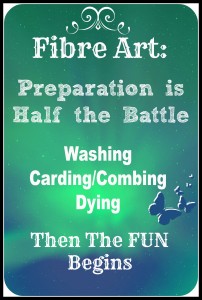This is part two in my three part series on fibre preparation for successful fibre art. Part one dealt with fleece, roving, yarn, and fabric preparation through washing. This part two deals with fleece and fibre preparation through the carding, or combing process.
Often it is not clear what processing fibre does, or it is confusing. Should you card or comb your wool? Is it necessary for llama or angora rabbit to be processed in this manner? How do drum carders, hand cards, and combs differ, and how does that change the end result?
Before you Card:
The pre-carding preparation is as essential as the carding itself. For carding or combing you need clean, non-greasy, and slightly fluffy fibre. For wool that means picking the fibre first, for llama that could just mean shaking it around a bit. Picking is the not so technical term for hand-breaking the lock structure of wool fibres, and turning those crisp and tight locks into a loose fluffly cloud that the carding will straiten into a nice roving. If you do not pick the fibres first, you risk tangling your drum carder teeth, and/or having to put the fibre through five or six times, instead of just three.
To Card or Comb?
Carding can be accomplished with drum carders, electric carders, or hand cards. The question is, for what purpose are you preparing your wool? If you want a perfectly consistent and even yarn, I would recommend combing or using hand-cards. If you want a slubby novelty yarn, or want to felt with the fibre, I would recommend a drum carder.
Combing is versatile, possibly more so than carding. Combing can be done at any time, and anywhere that you have your fibre and a comb. It’s not quite as easy to haul a drum carder around. Combing keeps the fibres perfectly alined as they are in the natural lock structure. This makes it useful for small projects, or for achieving a fine yarn. A combed lock of wool acts like a short bit of top. It is perfect for fine and even yarns. Combs used can be simple dog combs, dog brushes, or specialized “flick-carders” all work alike and help you keep your wool strait and aligned.
Drum carders, or hand cards, are perfect for blending, felting, or spinning a sport-weight or higher yarn. The fibres will not be completely aligned, but will be smooth and mostly tangle-free, if you picked the fibre first. The carder gives you the ability to blend long and short fibres, like small amounts of silk, yak, angora, or sparkles with your normal plain, or naturally dyed, wool. It is a perfect time to experiment and have some fibre fun.
Back to You:
What do you like to create with your fibre? What fibre preparations do you end up using to do so? Is there a preparation I have not covered that you would like to see covered? I would love to hear your thoughts, leave a comment.